|
November Tank of the Month
Jim LaMunyon

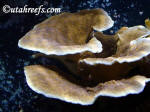
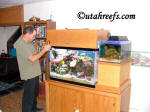

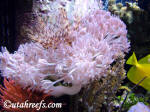


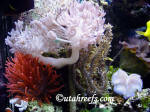
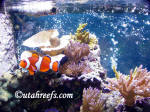






Check out the PowerPoint presentation on
Jim's tank by clicking here!
November’s tank of the month is owned by one of our northern most
members. The aquarium set up is well thought out and provides an
environment where many different fish and coral species thrive. The
tank contains a diverse mix of both hard and soft corals. In fact,
two of the most stunning corals are a plating montipora and a large
sarcophyton. Jim and his family are enthusiastic about sharing their
aquatic hobby with visitors. If you ever find yourself near Logan,
take the time to see this tank! Thanks again to Jim and his family
for showcasing their tank with the WMAS!
1) Your name, location and occupation. Include how long you have
been an aquarist, how long you have been a WMAS member and how you
heard of our club.
Name: Jim LaMunyon
Location: Richmond, Utah
Occupation: Chemist
How long have you been in the hobby? 3 years
How long have you been a member of the club? 3 years
How did you hear about the WMAS? I found the WMAS website
before moving to Utah from Oregon. I had originally planned to set
up there, but due to a job change, held off until after the move.
2) Describe your tank. Acrylic or glass? Size in dimensions and
gallons. How long has it been set up?
Acrylic / Glass: AGA glass with corner overflow
Size in gallons: 65
Dimensions: 36” x 18” x 22”
Age: (how long has the system been running) System has been
up for 2.5 years.
3) Describe your lighting system, including your photo-period.
Add what you would change if you could.
Twin 175W 10k MH bulbs provide lighting with actinic supplementation
from two 40W fluorescent bulbs. This was purchased as a ‘retro-kit’
from Hamilton technology. The refugium mounted to the side (and
above) is lit by an 18W 50/50 bulb. The RDP sump is lit by the Home
Depot ‘Lights of America’ outdoor 65W PC bulb/housing purchased for
$30.
The actinics are on for 11 hours/day and the MH for 9 hours. The
sump in the stand is lit on a reverse cycle from the MH bulbs.
4) Describe your filtration system. Include: How deep is your
sand bed, plenum, your skimmer size and model and how long you run
it, your circulation pumps (how many and their size in gallons per
hour), your sump/refugium including Reverse Daylight, biowheels and
skilters, HOT systems, clean up crew.
Filtration is provided from a number of sources. The tank has 65#
Fiji liverock and about 40 pounds of the infamous aragocrete for
base rock. There is around 200# of oolitic sand in the
tank/sump/refugium bringing the deep sand bed/worm farm to around 4”
depth in the main tank. There are three powerheads and a return to
provide circulation. One of the powerheads feeds the display
refugium, pumping water up from the main tank. There are no siphons
on this system; all the return water flow between the tanks is all
by gravity overflows. The main return pump in the sump is a Sen 700.
Algae caulurpa, etc. is harvested and discarded regularly. The
system has light skimming provided by an inexpensive SeaClone
skimmer.
Lots of critters from worms, snails, small crustaceans, hermit
crabs, miniature brittle stars, etc. make up the clean-up crew. I’m
always looking for more, if anyone has a few stomatella sp. snails
they would like to part with (hint, hint). Soon after setting up the
tank, I added fish, mostly from Bird World, as Logan has no pet
store carrying salt water livestock. Immediately all the crustaceans
(amphipods, hermits, shrimp, etc.) died. I assume it was from adding
water (with copper) from the pet store to the tank. I ran an ion
exchange resin for about 6-8 months to chelate the metals out. Every
few weeks I would add some amphipods, mysis, and copepods siphoned
from a friend’s tank. After the running the resin for 8 months, they
started to survive and multiply. The algae then slowly receded. I
also added a couple more tangs (for a total of 3) to add their
efforts. The hair algae has since evacuated the main tank for the
more benign areas of the sump and refugium.
5) What are your maintenance techniques? Include water change
schedule.
I change about 5-10% of the water a month, depending on how
ambitious I am feeling. I also change the carbon every couple
months. The make-up water is run through a RO unit before use.
6) What additives do you use? Kalkwasser, Strontium, Molybdenum,
Iodine, Magnesium, Other
The only additives I use are the SeaChem Reef Builder (alkalinity)
and Reef Advantage (calcium). These are bought dry and what is
needed is dissolved in a little water before adding to tank. I also
have some buffer, but haven’t used too much since the pH has held
fairly stable.
7) Describe your feeding philosophy. Include your schedule, and
what you prefer to feed your system?
I feed my tank daily and alternate between Vibragro pellets and
Formula Two. Once or twice a week I will add a little Cyclops-eze
for the corals. At the same time I usually add some golden pearls
(active sphere size) and Tahitian Blend algae paste for the clams. I
feed quite a bit, but that is mostly due to a lack of hair algae in
my main tank. When I went through my algae bloom, I fed less to
force the tangs to forage more. I originally bought the Cyclops-eze
when I purchased a mandarin dragonette a few months ago. It was
feeding on it in the store. However, I have yet to see the mandarin
feed on the Cyclops-eze in my tank. Go figure. I used to feed the
rose BTA anemone, but got tired of it splitting frequently. Since
cutting it’s food intake by direct feeding, it has split only twice
and the growth between splits has slowed.
8) DIY ie, Calcium reactor, stand / hood, skimmer, sump, ect. Any
Do-it-yourself items of interest? Web-sites that you may have
referenced?
The stand is built of braced 2 x 4’s with an oak plywood cap and
trim. Nothing fancy. I also built the hood from oak and installed
the Hamilton lights. Some of the base rocks were aragocrete. That
idea came from Tom Miller (Smithfield, UT) and the GARF website. I
am take it or leave it on the looks of aragocrete, but since it is
under the natural live rock, you can’t really tell. It has also been
covered with corals, coralline, sponges, etc. The sump is a 20 gal
aquarium with acrylic dividers put in with a little silicon. The
sump also has a sand bed, live rock and is lit on a reverse cycle
from the halides. If I had it to do over again, I would build the
stand a little taller to facilitate working underneath. The plumbing
between the tanks is done with PVC from our friendly Home Depot.
9) Stand and Canopy
Wood: Oak Canopy, oak veneer plywood on stand.
Color: Natural with outdoor spar varnish (like on a cabin, or
outside door).
Special Characteristics: I did not enclose the hood totally, but
left strips in the top open for ventilation. Has a small fan that
blows air into the hood to keep from overheating with all that
light. Does increase evaporation a bit (~1 gal/day.
10) Items of interest: Favorite or unusual Fish, coral, or
invertebrate
Favorite Fish: Purple tang (me), mandarin (wife), clownfish
(kids)
Favorite Coral: I know everyone has it, but I like the
fluorescent ‘green slimer’.
Favorite Polyps: Several flavors of zoanthids, like the
purple ones.
Favorite Sponge: Have several types from the rock, the
yellow, encrusting is nice.
Favorite Crab: Only have 5-8 blue legs in the tank, so not
much selection there.
Favorite Worm: There are tiny feather dusters everywhere.
Orange ones best.
Favorite Clam: Have two crocea clams, like the blue color.
11) Can you include a table showing your elemental levels of Ca+,
alkalinity, S.G., temperature, pH and other interesting testables?
With all the stony corals, I use quite a bit of my two additives. I
try to keep the calcium level around 375-400 and alkalinity around
10-11. The pH has always been around 8.1 and doesn’t seam to
fluctuate much. Temperature at 78F, and S.G.=1.024. The main thing
is that I try to see if everything is out and extended. The only
real problems came with the crustacean crash and algae bloom after
first adding fish. Another bad experience was not testing for about
a month (or adding anything) and the alkalinity level got a bit low.
Now I usually test 1-2 times per week.
12) What experiences and challenges have you had with the tank?
Any lessons learned? Is there anything you do differently than
others (or differently than previously)? If so, why?
If I had it all to do over, I would go with a bigger tank since I am
nearly out of space. (I’m sure everyone else in the club (with the
possible exception of Jim Perry wishes they, too, had a bigger
tank.) A taller stand to make it easier to work underneath would
also be a great help. Also, when first set-up, I had a small mantis
shrimp come in with the live rock and it managed to eat a couple
nice shrimp dinners at my expense. I never could catch it to put in
a small tank of it’s own. The copper crash after adding the fish
store water got him (as well as every other crustacean in the tank).
One thing that greatly helped before setting up my tank was to go
see the 2001 reef tour shortly after moving to Utah. Anyone
contemplating this hobby should see a few tanks for ideas before
spending any $$$. For example, one of the best tanks on the 2001
tour was Chris Rodesh’s combination SPS/soft coral reef running an
inexpensive seaclone skimmer. Paul Taylor, on the 2003 tour, is
running a nice SPS tank, skimmerless. Lots of different things are
out there, and as long as people are attentive to their reef, most
can be successful. Even Adam’s dump-bucket, acrylic creation from
the 2001 tour was unique.
I also had a friend in Oregon that had a tank with one of these
veneered particle board stands purchased in a local pet shop. He had
a slow plumbing leak and later a collapse. As a result I overbuilt
my stand with 2 x 4’s then put on a plywood cap. Not as pretty as it
could be, but no problems (yet), either.
|